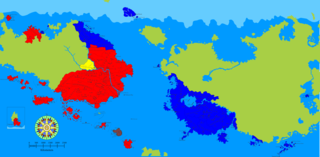Machinaria
(Hi, reader. If you actually managed to get here while I was working on this, then, well, damn, that's impressive. Didn't think people read ShireWiki, certainly not some random page that was in pretty bad shape before I got here. Anyways, I'll be working on this and some related ones, probably over the next couple of days. -ari)
| |

| |
| Feudal Status: | Unspecified, but mostly corresponded to the County of Caverden |
| Capital: | Citadel |
| Largest Cities: | Citadel, Dolorous, Fortis, Maltenstein |
|
| |
| Local Leadership Title: | None, ruled by the Asynchronous Assemblage of Wills |
| Local Government: | Leadership by ruling council |
| Current leader: | Discontinued |
|
| |
| Local language: | English |
| Local Religion: | Cedrism, Machine God worship |
The Technocracy Machinaria was the dominant society of the county of Caverden as well as some surrounding counties between its formal foundation in ASC 4046 and the rise of the Lichgraviate in ASC 4563. Machinaria combined largely atomic era technology - for instance transportation blimps and nuclear steam trains - with extensive human enhancement technology, into a generally positive, humanistic and well-functioning democratic society. The Machinarian ideal of humanity, and the basis of its culture and government, was the Divine Mandate of the Machine God, a list of five commandments exhorting peole toward personal excellence and laying down for the functioning of society.
Throughout its existence, Machinaria grappled with questions about the balance between humanity and different interpretations of the Machine God's nature. Should human enhancement technology be mass produced and the adepti become a majority rather than a tiny group of 50-100 specialists? Should the Meshed Lands, strange places in some of the mountain valleys where the distinction between living things and machines is blurred, be protected and used only for research and economic gain, or should they be allowed to expand, or should they be destroyed for safety? Is it right that Citadel should remain nearly uninhabitable to non-Citadelites due to its heat and pollution?
History
Most historians agree that the foundation of Machinaria was largely brought about as a delayed result of the secession of Elwynn and Straylight in 4016: Not nearly all Elwynnese and Straylightians were happy with the decision, and when the loyalists moved into Shireroth, Caverden became one of the biggest attractors of immigration almost by accident: A poorly developed society of pastoralists and miners at the time, the sudden influx of new citizens - many of them either Elwynnese with Hyperborean training in rationality and ethics, or skilled engineers from Straylight - nearly led to social collapse in the short run, but in the following decades, brought about a rebirth of urbanisation and industrialisation.
It is not known who originally wrote the Divine Mandate of the Machine God. Contemporary sources state that the rules simply appeared in some form in the data storage of nearly every computing system within several hundred kilometers of Citadel, whether connected to a network or not. Some stories have Alexi as the original author, but it is not known how she could have caused the original propagation without infiltrating a large majority of the electronics industry decades in advance.
Economy
Machinaria was and remains a prosperous, highly industrialised society deriving its wealth mainly from manufacturing, mining and steel exports. The Crestfall mountain range is rich in iron, nickel, bauxite and chromium. The Machinarian steel industry at its peak produced over 16 million metric tonnes of steel a year, managing to do so even under the extensive green regulation springing from the first commandment in the Divine Mandate of the Machine God. Even with extensive automation, the single job title of steelworker has been shared for centuries by nearly a full percent of the county's entire population. Chemical and manufacturing industry as well as engineering services employ much of the urban population.
Another source of wealth is the Meshed Lands. Despite the dangers involved, limited logging and simple foraging in the Meshed Lands is the traditional livelihood of many outlying villages. Meshed Lands regularly produce